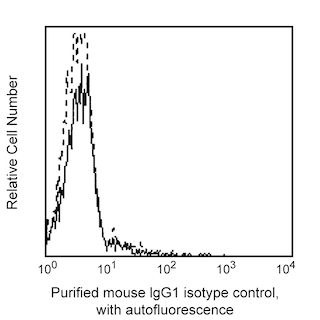Old Browser
This page has been recently translated and is available in French now.
Looks like you're visiting us from {countryName}.
Would you like to stay on the current country site or be switched to your country?




Flow cytometric analysis for CD121b expression on human cell lines. Jurkat cells (Human T-cell leukemia; ATCC TIB-152; Left Panel) or SR cells (Human lymphoblast; ATCC CRL-2262, Right Panel) were stained either with a Mouse IgG1, κ isotype control (Cat. No. 555746; dotted line histogram) or with the Purified Mouse Anti-Human CD121b antibody (Cat. No. 552401; solid line histogram) in conjunction with a PE Goat Anti-Mouse Ig secondary antibody (Cat. No. 550589). Flow cytometry was performed on a BD FACSCalibur™ flow cytometry system.


BD Pharmingen™ Purified Mouse Anti-Human CD121b

Regulatory Status Legend
Any use of products other than the permitted use without the express written authorization of Becton, Dickinson and Company is strictly prohibited.
Preparation And Storage
Product Notices
- Since applications vary, each investigator should titrate the reagent to obtain optimal results.
- An isotype control should be used at the same concentration as the antibody of interest.
- Caution: Sodium azide yields highly toxic hydrazoic acid under acidic conditions. Dilute azide compounds in running water before discarding to avoid accumulation of potentially explosive deposits in plumbing.
- Please refer to http://regdocs.bd.com to access safety data sheets (SDS).
- Sodium azide is a reversible inhibitor of oxidative metabolism; therefore, antibody preparations containing this preservative agent must not be used in cell cultures nor injected into animals. Sodium azide may be removed by washing stained cells or plate-bound antibody or dialyzing soluble antibody in sodium azide-free buffer. Since endotoxin may also affect the results of functional studies, we recommend the NA/LE (No Azide/Low Endotoxin) antibody format, if available, for in vitro and in vivo use.
- Please refer to www.bdbiosciences.com/us/s/resources for technical protocols.
Companion Products

.png?imwidth=320)

CD121b, also known as interleukin-1 receptor type II (IL-1RII), has a significant role in the inflammatory response. Interleukin-1 receptor type II acts as a decoy receptor to regulate prolonged persistence of IL-1 by binding to IL-1 and preventing the formation of signaling complexes. Membrane IL-1 type II receptor forms a 60 kDa soluble IL-1 receptor type II upon proteolytic cleavage from various cell types after activation with secondary, IL-1 induced cytokines. The soluble IL-1 type II receptor consists of 398 amino acids and 29 amino acids within a short cytoplasmic domain. The MNC2 monoclonal antibody reacts with recombinant and native soluble human IL-1 receptor type II.
Development References (3)
-
Bessis N, Guéry L, Mantovani A, et al. The type II decoy receptor of IL-1 inhibits murine collagen-induced arthritis. Eur J Immunol. 2000 March; 30(3):867-875. (Biology). View Reference
-
Neumann D, Kollewe C, Martin MU, Boraschi D. The membrane form of the type II IL-1 receptor accounts for inhibitory function. J Immunol. 2000 Septembr; 165(6):3350-3357. (Biology). View Reference
-
Orlando S, Sironi M, Bianchi G, et al. Role of metalloproteases in the release of the IL-1 type II decoy receptor. J Biol Chem. 1997 December; 272(50):31764-31769. (Biology). View Reference
Please refer to Support Documents for Quality Certificates
Global - Refer to manufacturer's instructions for use and related User Manuals and Technical data sheets before using this products as described
Comparisons, where applicable, are made against older BD Technology, manual methods or are general performance claims. Comparisons are not made against non-BD technologies, unless otherwise noted.
For Research Use Only. Not for use in diagnostic or therapeutic procedures.
Report a Site Issue
This form is intended to help us improve our website experience. For other support, please visit our Contact Us page.